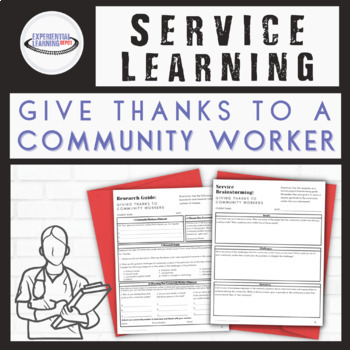Service-Learning Project for High School: Giving Thanks to Community Workers
- PDF
- Easel Activity
Description
Is it a good time for your high school students to give back? To show gratitude for someone outside of their circle? To observe and identify community needs and serve the community to meet those needs? To gain skills in communication, collaboration, compassion, problem-solving, creativity, and more? This self-directed service-learning project for high school students is all of that wrapped up in one experience.
Self-directed service-learning is when students give back to their communities through an act of service. Because the experience is self-directed, students examine community challenges and needs that are relevant and meaningful to them personally.
This resource is a bundle of templates that guide students through a self-directed service-learning project. This particular project focuses on the sacrifices that community workers make to better the community and thank those individuals for their work.
Each of your students will choose a community worker (ex: teacher, doctor, firefighter, veteran, etc.) to learn more about. They will connect with one community worker, interview that person to examine challenges and needs associated with that line of work, develop a service project to meet those needs or show gratitude to the community worker interviewed, and serve the community by serving that person.
The materials included in this resource guide students seamlessly through the process. The templates are intended to support independent and productive work on the part of your students. There is very little prep on your part. Simply introduce the experience, print the guiding templates, and facilitate experiences.
This resource includes a printable PDF, a digital Google Slides, and a digital TPT Easel option. This resource is not editable at this time.
Resource Includes:
- Teacher guide/facilitation steps
- Student project description and instructions
- Student project checklist
- Research guide
- Interview guide and notes
- Service brainstorming template
- Presentation planner
- Service project task list
- Service-learning project plan summary
- Service-learning project reflection
- Service-learning rubric
If you liked this resource, check out these products as well!
- Problem-Based Curriculum Tool Kits Bundle: Community Action Projects & Problem-Based Learning
- Self-Directed Project-Based Learning: Real-World Heroes
Helpful FREE resources from Experiential Learning Depot
- Project-Based Learning Outcomes Portfolio - Students can add learning outcomes from this projects and all other service-learning projects to showcase cumulative learning outcomes and the experience as a whole.
Helpful and Relevant Blog Posts from ELD
- How to Facilitate Self-Directed Community Action Projects
- How to Demonstrate Learning with Experiential Learning Digital Portfolios
Interested in new resource alerts, freebies, tips, tricks, and more?
- Click the green star to get new resource alerts
- Join my newsletter.
- Blog – Experiential Learning Depot
- Facebook.
- Facebook Group - Experiential Learning Community for k-12 Teachers
Earn TPT Credits:
Follow Experiential Learning Depot and earn TpT credits by giving feedback on this product. A sincere thank you for your business. Feel free to contact me through email at any time with questions on this product - experientiallearningdepot@gmail.com
Cover Font Credit: MR. FISK Fonts






